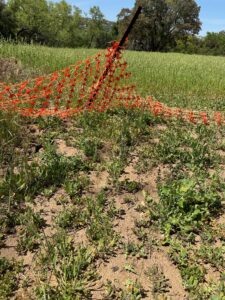Final report for FW22-402
Project Information
The drought associated with the climate change has left some traditional agriculture unsustainable and farmlands uncultivated in California. A new perennial cropping system offers sustainable economic opportunities for farmers. Our project will test a grain-type intermediate wheatgrass Kernza, that is genetically related to common wheat, in our local climate. We will develop the protocol and best practice to establish Kernza in our farmland and demonstrate the marketability of the grain and biomass products from the crops. If successful, the perennial Kernza will provide substantial environmental benefits relative to annual grain crops, including reduced soil and water erosion, reduced soil nitrate leaching, and increased carbon sequestration, which will help alleviate the effect of climate change. The reduced input of seed, tillage, energy, labor, and savings on fertilizer and pesticides all translate economic benefit for farmers. Our findings will show the viability of growing Kernza in southern part of the country, which so far is only grown in the northern part. We will communicate with agriculture professionals nationwide and statewide with our results and host outreach activities in our local communities and Indian reservations. We will also educate student and future farmers about the new cropping systems.
- to test if a perennial grain crop system can be established in the place of winter oat in local climate and find the best practice to grow it
- to measure grain and biomass feed production in year 1 and year 2 and determine the marketability and environmental benefit of the new crop
- to perform outreach to farmers in the community and educate students and next generation farmers about the new sustainable agriculture system
Please see the Gantt chart uploaded in support document if not showing up here by clicking "timeline"
Cooperators
- - Technical Advisor
Research
Objectives:
- To test if Kernza can be established as a perennial grain crop in the place of winter oat in local climate and to determine optimal conditions to grow it.
- to measure grain and biomass feed production in year 1 and year 2 and determine the marketability and environmental benefit of the new crop.
- to perform outreach to farmers in the community and educate students and next generation farmers about the new sustainable agriculture system.
We manually prepared the field to get rid of weeds and set up various conditions to establish the new crop.
A. planting time
September and October were the hot time of the year and wildfire season due to local Santa Anna wind conditions. Seeds could not germinate without rainfall or watering because the soil was so dry. Even with daily watering, seedling was not observed until 15 days after planting. The germination rate was 81%. The results in colder climate showed early planting time help the plants to establish and yield grains in the first season, for example, in Upper Midwest, Kernza needs to be planted by September 1 for the root to have enough time to establish before cold winter. But it is impractical in our climate to plant large field without irrigation as rain is rare. However, our mild winter may still allow the root to establish in a late planting time in November or December.
We planted on November 7 and December 26 just before a rain as we do with dry farming of winter oat in large fields. We will find out the relatively late planting time will yield grains in the first season. It took 10 days before any seedling appear and overall germination rate is 82% for November and 85% for December.
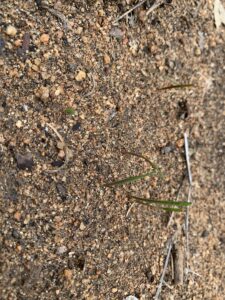
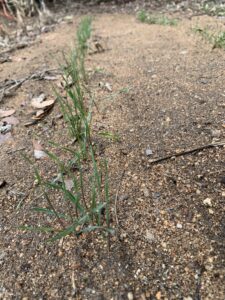
We planted the seeds in the second year also in December to proceed a forecasted rainfall.
B, seeds density
We obtained only 150 g of seeds. So we planted only one density at about 5 seeds per inch in 2 feet rows. Planting depth is about 1 cm. In some areas, we also planted seeds in a cluster of 10.
C. Soil type
We planted in one area with sandy loam prime soil and another area with soil with more clay content. The plants in the sandy loam soil generally grew taller and produced more biomass.
D. Effect of fertilizer on the growth and yield
We applied organic fertilizer chicken manure on some cluster of plants in the second year. The clusters with fertilizer produced the tallest plants at flowering time (6.5 ft) and more biomass among all the plants.
E. Temperature
Last two years, we had mild winter (no snow) and more than average precipitation. We had good vegetative growth of Kernza and grain formation. Our local climate satisfies the requirement of minimal number cold days of 3 weeks with 40F or lower overnight temperatures. Therefore, there is no concern of growing Kernza in east San Diego region climate wise.
F. Animal pest control
We planted in both fenced and unfenced areas. In one unfenced area, the seedlings were kept eaten by unknown critters, possible rabbits, rodents or insects. It is likely due to no other palatable vegetation around. It should be okay when planting in a large field, where plants on the edges of the field will be eaten but, in the center, will survive.
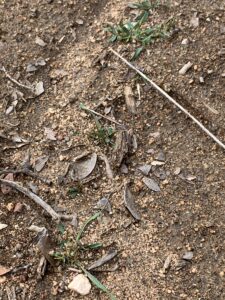
We are excited to observe that in fenced area the wheatgrass Kenza is growing well.



The mild climate in southern California and late planting time (November or December to wait for the rain) created uncertainty whether we will get grains from this wheatgrass as kernels need certain chill hours to form. We are happy to observe flowers and then grains forming in our plants. The grains harvested were used for 2nd year planting and they yield seedlings at a germination rate of 80%. Therefore, we have proved that Kernza wheatgrass can successfully produce grains in our local climate.

The wheatgrass plants in the unfenced field did not grow well, unlike those the fenced area. Although they germinated without problem, they were slow in gaining biomass. They were in an area next to the winter oat field which was planted at about the same time, but their growth lagged behind the oat seedlings.
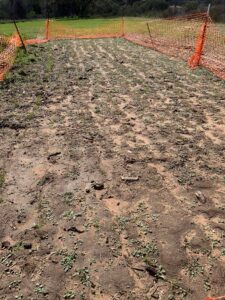
The oak field was sprayed with herbicide once and had no weed problem, but the area wheatgrass area was not spayed and was taken over by weeds, and the Kernza seedlings remained small and did not grow bigger. By summer, no wheatgrass established in the open field and gopher holes were abundant in the area.
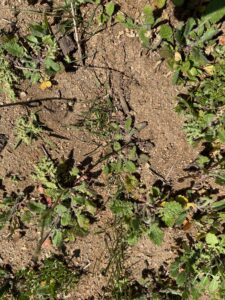
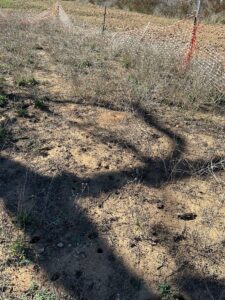
We believe the field planting failed due to the pressure from weeds and pests. To pinpoint the problems in the 2nd year, we created a small fenced corner in the field and manually pull weeds.
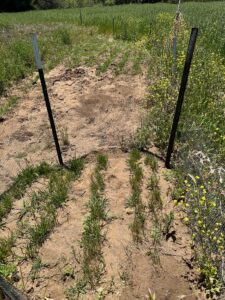
The Kernza plants grew well in field, especially in the fenced corner. The middle section in the picture above was destroyed by ant colonies, another pest we identified. In the first year, Kernza plant growth in height lagged behind the oat planted about the same time. It may catch up in the 2nd year.2. to measure grain and biomass feed production in year 1 and year 2 and determine the marketability and environmental benefit of the new crop.
In June and July, the wheatgrass started to turn yellow and dry. We harvest the grains before they started to fall to the ground. We also harvested the biomass to use for animal feed.
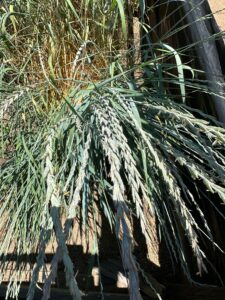
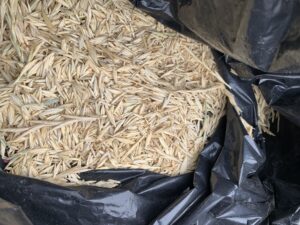
From an area of 400 sq ft that kernza growed well, we obtained 1250 gram of whole grains. We obtained 15 lb of half dried biomass for feed.
By November, the new growth formed from plants a year ago, showing the perennial nature of the wheatgrass.
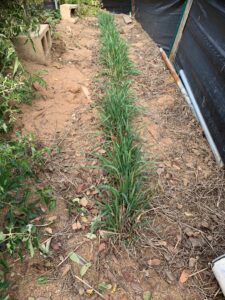
After a mild winter, the growth really took off in February.
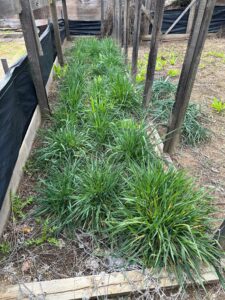
In the second year, from an area of 500 sq ft, we obtained 1700 grams of whole grains. We obtained 26 lbs of half dried biomass for feed.
3. to perform outreach to farmers in the community and educate students and next generation farmers about the new sustainable agriculture system.
We have hosted a visit by Elizabeth Garcia, Gregg Cady and Joel Kramer the Resource Conservation District of Greater San Diego County (RCD) to showcase the wheatgrass project. They will write a carbon farm plan which will include the perennial wheatgrass experiment to look at the environmental benefits and develop a recommendation for other farmers. The RCD covers a service area of approximately 1,847,300 acres in San Diego County and will be a great partner for our outreach effort.
We hosted on-farm demos to several interested farmers and distributed Kernza flyers.
Research Outcomes
Our study is the first report of growing Kernza in the most southern part of the country. We have demonstrated that it is feasible to grow Kernza in our climate perennially with harvest of both grains and biomass for feed. We also showed the environmental benefits Kernza could bring with its deep root systems. With hundreds of acres of farmland in East San Diego County and thousands more in Imperial County where wheat and hay are grown, switching to Kernza worth a consideration. In small farms where it is impractical to harvest the grain with large equipment, it may be better to just keep the grains in the bale to increase the feed value for animal feed. Kernza may also serve as a weed control and erosion control measure for the field during the winter rainy season.
Education and Outreach
Participation Summary:
I spoke to county officials on Pilot Carbon Farming initiatives to introduce our project.
I attended San Diego County Voluntary Conservation and Land Management Assistance Workshop to speak with agriculture professionals and farmers/ranches to spread words of our project.
At our farm demonstrations, we spoke to several interested farmers. Our region has many small farms or landowners with 20 acres or less farmland. While it is impractical to harvest the grain with large equipment at this scale, it may be better to just keep the grains in the bale to increase the feed value for animal feed. They are also very interested in growing Kernza as a measure of weed and erosion control for the field during the winter rainy season. Grazing in the spring at an early point will not affect yield in the fall according to a study. This is also attractive to ranchers.
We formed new partnership with the Resource Conservation District of Greater San Diego County to develop a carbon farm plan and assist our outreach efforts in their service area.
I gave PowerPoint presentation about Kernza to students at Grossmont Union High School District who grow over 500 acres of winter oat in our local area. Showing them perennial wheatgrass is viable in our area and convincing them to switch will change their mind of traditional farming and have a big impact on their thinking about future farm practices.
We provided wheatgrass biomass as feed to our neighbor San Diego Animal Sanctury and Farm. Their animals liked it and they plan to grow some.
The stakeholder of Evergreen farm which has over 1000 acres of farmland in Campo, CA is interested in growing Kernza based on our results. We also reached out to a farmer in Imperial County who grows thousands of acres of wheat and hay to inform him about the perennial Kernza corp.
Education and Outreach Outcomes
I had a meeting with Ariel Hamburger and Clare Moss from San Diego County Pilot Carbon Farming Program to introduce perennial crop as a way to reduce carbon emission by farming. They are very interested in the outcome of this project and possible impact on the region.
We formed new partnership with the Resource Conservation District of Greater San Diego County to develop a carbon farm plan and assist our outreach efforts in their service area.
